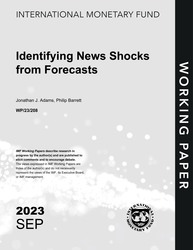
Identifying News Shocks from Forecasts
Identifying News Shocks from Forecasts
READ MORE...
Volume/Issue:
Volume 2023
Issue 208
Publication date: September 2023
ISBN: 9798400257377
$20.00
Add to Cart by clicking price of the language and format you'd like to purchase
Available Languages and Formats
| English |
Prices in red indicate formats that are not yet available but are forthcoming.
Topics covered in this book
This title contains information about the following subjects.
Click on a subject if you would like to see other titles with the same subjects.
Inflation , Economics- Macroeconomics , Public Finance , Economics / General , Identification , Structural shocks , SVAR , News , Fiscal multiplier , Fiscal policy , Monetary policy , Policy counterfactuals , monetary policy shock , coordinated fiscal policy , using forecast data , data from the SPF , impulse response , Inflation , Vector autoregression , Fiscal stimulus , Global
Summary
We propose a method to identify the anticipated components of macroeconomic shocks in a structural VAR. We include empirical forecasts about each time series in the VAR. This introduces enough linear restrictions to identify each structural shock and to further decompose each one into “news” and “surprise” shocks. We estimate a VAR on US time series using forecast data from the SPF, CBO, Federal Reserve, and asset prices. Unanticipated fiscal stimulus and interest rate shocks we identify have typical effects that match existing evidence. In our news-surprise decomposition, we find that news drives around one quarter of US business cycle volatility. News explains a larger share of the variance due to fiscal shocks than for monetary policy shocks. Finally, we use the news structure of the shocks to estimate counterfactual policy rules, and compare the ability of fiscal and monetary policy to moderate output and inflation. We find that coordinated fiscal and monetary policy are substantially more effective than either tool is individually.
Copyright © 2010 - 2025
Powered by:
AIDC



